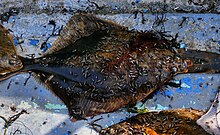| Seaweed or kelp flies | |
|---|---|

| |
|
Scientific classification
| |
| Domain: | Eukaryota |
| Kingdom: | Animalia |
| Phylum: | Arthropoda |
| Class: | Insecta |
| Order: | Diptera |
| Superfamily: | Sciomyzoidea |
| Family: |
Coelopidae Hendel, 1910 [1] |
| Type genus | |
|
Coelopa
Meigen, 1830
| |
| Synonyms | |

The Coelopidae or kelp flies are a family of Acalyptratae flies (order Diptera), they are sometimes also called seaweed flies, although both terms are used for a number of seashore Diptera. Fewer than 40 species occur worldwide. The family is found in temperate areas, with species occurring in the southern Afrotropical, Holarctic, and Australasian (which has the most species) regions.

Family characteristics
Coelopids are small to medium-sized (2.5–9 mm (0.098–0.35 in), usually 4–7 mm (0.16–0.28 in)), robust flies, predominantly with a flat body and darkly coloured. Coelopidae species are usually densely bristly or hairy. Their eyes are small. The arista is bare to pubescent. Ocelli and ocellar bristles are present. The postvertical bristles are parallel or converge. The two pairs of frontal bristles curve outward and scattered interfrontal setulae are present. Vibrissae are absent, but strong bristles occur near the vibrissal angle. The mesonotum is flat and the prothorax is separated from the propleuron by a membrane. The legs bear strong bristles and soft, dense hairs and the tibiae have subapical bristles. The wing is unmarked. The costa is entire, without interruptions. The subcosta is complete, crossvein BM-Cu is present, and the anal cell (cell cup) is closed. Legs usually densely hairy.
Biology
Coelopids are found in the wrack zone of temperate seashores where the larvae feed on rotting seaweed. They are sometimes very abundant in this habitat. They go through several generations a year. The females lay their eggs in small batches into fresh alga banks. Three larval instars occur. Larvae feed in a bacteria-laden mass. Pupation is seldom in the algal substrate that soon collapses, but more frequently in the highest sand layers. Larvae are also found in winter wrack heaps as bacteria raise temperatures to 20-30 °C even if the heap is superficially frozen. Larvae and pupae have numerous predators, including birds and the staphylinid Aleochara and suites of parasites confined to algal banks.
Classification
As of 2011 [update], following Mathis and McAlpine's taxonomy, Coelopidae consists of two subfamilies: Coelopinae, with three tribes, twelve genera, and twenty-eight species, and Lopinae, consisting of just one monospecific genus. [2]
- Subfamily
Coelopinae
Hendel, 1910
[1]
- Tribe Coelopini Hendel, 1910 [1]
- Tribe Coelopellini McAlpine, 1991 [4]
- Tribe
Glumini McAlpine, 1991
[4]
- Genus Chaetocoelopa Malloch, 1933 [3]
- Genus Coelopina Malloch, 1933 [3]
- Genus Dasycoelopa Malloch, 1933 [3]
- Genus Gluma McAlpine, 1991 [4]
- Genus Malacomyia Haliday in Westwood, 1840 (sometimes placed in Dryomyzidae[ by whom?])
- Subfamily Lopinae McAlpine, 1991 [4]
Other
Coelopa frigida (Fabricius) has been reared in the laboratory and used for genetic studies.
See also
References
- ^ a b c Hendel, Friedrich Georg (1910). "Über acalyptrate Musciden". Wiener Entomologische Zeitung. 29: 101–127. Retrieved 24 November 2019.
- ^ Mathis, Wayne N.; McAlpine, David K. (2011). "A Catalog and Conspectus on the Family Coelopidae (Diptera: Schizophora)". In Brake, Irina; Thompson, F. Christian (eds.). Contributions to the Systema Dipterorum (Insecta: Diptera). Myia. Vol. 12. pp. 171–205. hdl: 10088/18924. ISBN 978-954-642-599-7.
- ^ a b c d e Malloch, J. R. (1933). "The genus Coelopa Meigen (Diptera, Coelopidae)". The Annals and Magazine of Natural History. 11 (10): 339–350. doi: 10.1080/00222933308673666.
- ^ a b c d e f g h McAlpine, David K. (1991). "Review of the Australian kelp flies (Diptera: Coelopidae)". Systematic Entomology. 16: 29–84. doi: 10.1111/j.1365-3113.1991.tb00573.x. S2CID 83627067.
- ^
a
b Lamb, C. G. (1909).
"The Diptera of the subantarctic Islands of New Zealand. Pp. 124-145. In Chilton, C. (ed.), The subantarctic islands of New Zealand". Canterbury, Wellington: Phil. Inst.: xxxv + 388 pp. Retrieved 1 December 2019.
{{ cite journal}}: Cite journal requires|journal=( help)
Further reading
- McAlpine, David K. (1991). "Review of the Australian Kelp Flies (Diptera: Coelopidae)". Systematic Entomology. 16: 29–84. doi: 10.1111/j.1365-3113.1991.tb00573.x. S2CID 83627067.
- McAlpine, David K. (1998). "Family Coelopidae". In Papp, L.; Darvas, B. (eds.). Contributions to a Manual of Palaearctic Diptera. Vol. 3. Budapest: Science Herald. pp. 335–340.
- Meier, Rudolf; Wiegmann, Brian M. (2002). "A phylogenetic analysis of Coelopidae (Diptera) based on morphological and DNA sequence data". Molecular Phylogenetics and Evolution. 25 (3): 393–407. doi: 10.1016/S1055-7903(02)00276-2. PMID 12450746.
External links
- Tree of Life Coelopidae
- Family Coelopidae at EOL
- Diptera.info Images
- BugGuide images
- [1]
- Image of pupa
Identification
- Hennig. 1937. Coelopidae.In: Lindner, E. (Ed.). Die Fliegen der Paläarktischen Region 5, 52, 1-38.Keys to Palaearctic species but now needs revision (in German).
- Malloch, J.R. 1933. The genus Coelopa Meigen (Diptera, Coelopidae). Ann. Mag. Nat. Hist. (10) 11: 339–50.
- McAlpine, David K. (1991). "Review of the Australian Kelp Flies (Diptera: Coelopidae)" (Print). Systematic Entomology 16: 29–84.
- Séguy, E. (1934) Diptères: Brachycères. II. Muscidae acalypterae, Scatophagidae. Paris: Éditions Faune de France 28. virtuelle numérique
- Shtakel'berg, A.A. Family Coelopidae in Bei-Bienko, G. Ya, 1988 Keys to the insects of the European Part of the USSR Volume 5 (Diptera) Part 2 English edition.Keys to Palaearctic species but now needs revision .